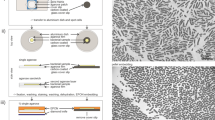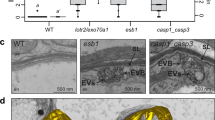Abstract
DURING an examination of the sieve plates of Cucurbita already briefly reported1, some observations on the structure of the secondary wall in the protoxylem have been made which seem worth recording.
This is a preview of subscription content, access via your institution
Access options
Subscribe to this journal
Receive 51 print issues and online access
$199.00 per year
only $3.90 per issue
Buy this article
- Purchase on Springer Link
- Instant access to full article PDF
Prices may be subject to local taxes which are calculated during checkout
Similar content being viewed by others
References
Hepton, C. E. L., Preston, R. D., and Ripley, G. W., Nature, 176, 868 (1955).
Crüger, H., Bot. Z., 13, 601 (1855).
Barkley, G., Bot. Gaz., 83, 173 (1927).
Sinnot, E. W., and Bloch, R., Amer. J. Bot., 32, 151 (1945).
Majumdar, G. P., Proc. Leeds Phil. Soc., 3, 642 (1940).
Author information
Authors and Affiliations
Rights and permissions
About this article
Cite this article
HEPTON, C., PRESTON, R. & RIPLEY, G. Electron Microscopic Observations on the Secondary Wall of the Protoxylem of Cucurbita . Nature 177, 660–661 (1956). https://doi.org/10.1038/177660a0
Issue Date:
DOI: https://doi.org/10.1038/177660a0
This article is cited by
-
Palm “wood”
Wood Science and Technology (1976)
-
Cell wall organization in higher plants I. The primary wall
The Botanical Review (1962)
Comments
By submitting a comment you agree to abide by our Terms and Community Guidelines. If you find something abusive or that does not comply with our terms or guidelines please flag it as inappropriate.



